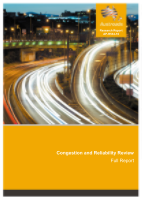Network

Congestion and Reliability Review: Full Report
- Publication no: AP-R534-16
- ISBN: 978-1-925451-49-8
- Published: 14 December 2016
- PDF (free) Download
The Congestion and Reliability Review measures the levels of congestion across major cities in Australia and New Zealand and identifies the key causes of congestion.
The report proposes an approach to identifying and assessing congestion interventions and overlays the key areas of focus for road and transport agency capability development to assist agencies in developing a congestion mitigation roadmap.
A summary report is also available.
- Foreword
- Contents
- Executive Summary
- Chapter 1 – Background
- Chapter 2 – Customer Perspectives
- Chapter 3 – Congestion Performance
- Chapter 4 - Causes of Congestion
- Chapter 5 – Congestion Interventions
- Chapter 8 – Congestion Mitigation Roadmap
- Chapter 6 - Capability Requirements
- Chapter 7 – Congestion Technology Development
- 1. Background
- 1.1. ANZ Road and Transport Demand
- 1.1.1. Demand Drivers
- 1.2. ANZ Road and Transport Supply
- 1.2.1. Road Supply
- 1.2.2. Road Infrastructure Investment Trends
- 1.2.3. Alternative Transport Supply and Expenditure
- 1.2.4. Interactions of Supply and Demand
- 1.2.5. Customer Demand
- 1.3. Definitions of Congestion
- 1.3.1. Existing Congestion Definitions
- 1.3.2. Congestion Definitions Used
- 1.3.3. Comparison with NPI definitions
- 1.4. Impact of Congestion
- 2. Customer Perspectives on Congestion
- 2.1. Road user satisfaction
- 2.1.1. Customer Satisfaction
- 2.1.2. Information and forecasting
- 2.1.3. Congestion and Liveability
- 2.2. ‘Acceptable’ congestion
- A. Commute Time
- B. Stability of Commute Time
- C. Reliability
- D. Productivity
- E. Economic Cost
- 3. Congestion Performance
- 3.1. ANZ Weekday Congestion Performance
- 3.1.1. Average Speed
- 3.1.2. Travel Time Delay
- 3.1.3. Reliability
- 3.1.4. Morning and Afternoon Peak Scheduling
- 3.2. ANZ Weekend Congestion Performance
- 3.2.1. Average Speed
- 3.2.2. Travel Time Delay
- 3.3. Congestion Performance of ANZ Cities and International Comparators
- 3.3.1. Group 1 (Sydney, Melbourne) vs. International Comparators
- 3.3.2. Group 2 (Perth, Brisbane, Adelaide, Auckland) vs. International Comparators
- 3.3.3. Group 3 (Darwin, Wellington, Hobart, Canberra) vs. International Comparators
- 3.3.4. Megacities
- 4. Congestion Causes
- 4.1. Key Causes of Congestion
- 4.1.1. ANZ Congestion Causes
- 4.1.2. Congestion Causes - Group 1
- 4.1.3. Congestion Causes - Group 2
- 4.1.4. Congestion Causes - Group 3
- 4.2. Congestion Model
- 4.2.1. Methodology
- 4.2.2. Recurrent Congestion Variables
- 4.2.3. Non-Recurrent Congestion Variables
- 4.2.4. Travel Time Variable
- 5. Congestion Interventions
- 5.1. Intervention Framework Overview
- 5.1.1. Intervention Framework
- 5.1.2. Benefit-Cost Analysis
- 5.2. Intervention Application
- 5.2.1. Location-Specific Filtering
- 5.2.2. Cause-Specific Filtering
- 5.2.3. City-Specific Considerations
- 5.2.4. Combining Interventions
- 5.2.5. Implications
- 6. Capability Requirements
- 6.1. Capability Maturity Framework
- 6.2. Relevant Capabilities for Interventions
- 7. The Future of Congestion Mitigation
- 7.1. Enhanced ITS Infrastructure
- 7.2. Regulatory Framework
- 7.3. Congestion Relief Innovations
- 7.3.1. New Mobility Services
- 7.3.2. New Data Services
- 7.3.3. Dynamic Demand Management
- 7.3.4. New Kinds of Vehicles
- 7.4. Blue Sky… 2025 onwards
- 7.4.1. Hypotheses: 10+ years
- 7.4.2. Major Implications
- 7.4.3. Predictions… 2025 onwards…
- 8. Congestion Mitigation Roadmap
- 8.1. Congestion Mitigation Goals
- 8.2. Impact of Technology
- 8.2.1. Mobility Services
- 8.2.2. New Data Services
- 8.2.3. Dynamic Pricing Mechanisms
- 8.2.4. New Kinds of Vehicles
- 8.3. Congestion Mitigation Cycle
- Appendix A Methodology
- A.1 Google Data Context
- A.1.1 Source of Data
- A.1.2 Google Application Programming Interface
- A.1.3 Data Specification
- A.1.4 Data Integration Methodology
- A.1.5 Use of the Data Output
- A.2 Road Agency Data Requests
- A.2.1 Agencies Contacted
- A.2.2 First Round Data Request
- A.2.3 Second Round Data Request
- A.3 Comparator City Selection
- A.3.1 Data Sources
- A.3.2 Clustering Analysis
- A.3.3 Post Clustering Ranking
- A.4 Road Selection
- A.4.1 Australian and New Zealand Cities
- A.4.2 Comparator cities
- A.5 Road Segmentation and Data Capture from Google
- A.5.1 Re-Projection
- A.5.2 Segmentation
- A.5.3 Validation
- A.5.4 ANZ segments and comparator cities
- A.6 Average Speed Methodology
- A.6.1 Measuring City-wide Average Speeds
- A.6.2 The Distribution of Road Segment Speeds Within a City
- A.6.3 Comparability Across Cities
- A.6.4 Avoiding Discreteness
- A.6.5 Interpretation in this Context
- A.7 Congestion Cause Methodology
- A.7.1 Model inputs
- A.7.2 Model Specification
- Appendix B Congestion Performance Outputs – City-Specific
- B.1 Sydney Congestion Performance
- B.2 Melbourne Congestion Performance
- B.3 Perth Congestion Performance
- B.4 Brisbane Congestion Performance
- B.5 Adelaide Congestion Performance
- B.6 Auckland Congestion Performance
- B.7 Darwin Congestion Performance
- B.8 Wellington Congestion Performance
- B.9 Hobart Congestion Performance
- B.10 Canberra Congestion Performance
- Appendix C Congestion Interventions
- C.1 Intervention Framework Details
- C.1.1 A. Improve Planning (10-30 years)
- C.1.2 Shift Modes (5-10 years)
- C.1.3 Change Behavior (2-5 years)
- C.1.4 Optimise Capacity (1 to 2 years)
- C.1.5 Operate Effectively (C.2 Benefit-Cost Analysis
- Appendix D Capability Maturity Assessment
- D.1 Group-specific Outputs
- D.2 Detailed Capability Overview and Maturity Assessment
- D.2.1 Strategy and Program
- D.2.2 Delivery Framework
- D.2.3 Project Delivery
- D.2.4 BAU Operations (Intervention-Specific)
- Appendix E Additional Travel Time and Variability Analysis
- E.1 Introduction
- E.2 Data Analysis and Estimation
- E.3 Results
- E.4 Use and Interpretation
Related publications
AP-R533-16
Latest Network News
